
|
|
7 December, 2002
7 December, 2002
Up at the crack of dawn today ! I didn't have my computer - that's
the only clock I have - and it looked very bright outside, so I got
up. Things to do! Bai's waiting for me ! Don't want to miss
breakfast! I asked the first guy I saw : 4 o'clock!
I'm up now. Over to the dome, take in some of that cool crisp air.
The Jamesway where I'm sleeping is a fancy tent with a blasting
heater that would dry out even Sponge Bob. 4 hours later (really, I
had that much computer work to do, making movies, processing
pictures, uploading, sending emails¯) it was time for breakfast. I
hope you¸re looking at those movies.
Ran 2 experiments with the portable detector today. The solar
experiment was pretty conclusive: no charged parcticles seem to reach
us directly from the sun. Otherwise, the graph should have shown a
rising trend at around 100 minutes, as the sun "moved" to a position
directly perpendicular to the detectors. No direct parcticles, hmm,
that's probably a good thing, health-wise.
See the graph in the picture section today for more on this. Solar
parcticles are fairly low energy, and are pretty unlikely to penetrate
through the atmosphere to where we are. That's true even at the pole,
where the pressure altitude has hovered around 10,500 feet since I've
been here. Question: why the downward trend in the graph? I have an
idea, so check tomorrow.
I also ran a set of shielding experiments, based on an intriguing
result from the first day of running the detector. First day: count
rate inside the SPASE shack was higher than outside. 2 possibilities
: colder PMTs create less background noise, lowering total counts,
OR, roof of SPASE shack provides interaction medium for charged
parcticles, and they create showers of secondaries inside the shack.
Bai suggested we borrow some metal plates from MAPO and run some
shielding experiments. But they were inconclusive. They were only 10
minute experiments, and tomorrow, I'll run these again, and see if I
can get some numbers that make more sense.
The ice tank occupied most of our day. We put it back together,
covering it up and making it light tight so we could run some checks
to make sure it's all working.
Badness! The two PMTs set into the top of the ice are not sending a
signal. Lots of troubleshooting, one of us in the shack, one in the
pit, testing resistances and voltages. No problems in the cables out
to the pit is a big relief, as they are buried and nearly impossible
to dig up. We finally traced it to the cable connector on the high
voltage PMT supply. It seems these are getting warmed by the sun, the
refreezing as soon as they¸re covered up again, and the ice prevents
a connection.
We tried drying them with a heat gun, tried inserting extra wire in
the holes to really get metal jammed onto metal. Each idea took a
while to execute. Open the tank, fool around with the connectors,
seal the tank back up. Fortunately, it was a warm windless day. To
windless to fly a kite, even (we tried).
Very frustrating. We'd get signal briefly, then lose it. Tomorrow: we
cut the connectors out and solder the cables together.
Not good. This tank is a prototype for nearly 200 in the ICETOP
array, and the connectors are in general use in AMANDA. Hopefully,
they perform better when frozen permanently into the ice.
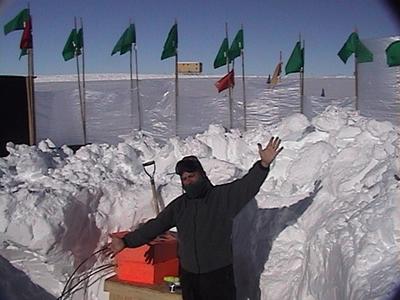
In the pit ! We spent a lot of time down in the pit today, and at times, I could actually feel the warmth of the sun through my sweater. The key to staying warm is to adjust your clothing constantly. When we're working, there's no need to wear the heavy parka, especially on a day like today was, with almost no wind.

Here's the way my portable cosmic ray detector looked when I checked in luggage at the Seattle airport. Let's see, some batteries, some wires, a timer looking thing, and some weird stuf in foam. Needless to say, it got a thorough inspection.
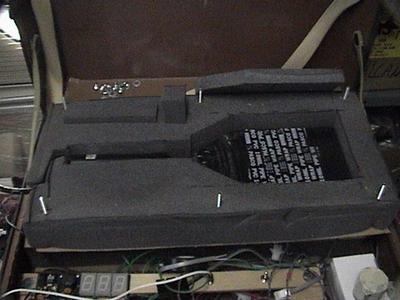
PMTs are pretty fragile and easy to break in shipping. I came up with this system in the 3 days between the arrival of the PMTs and my departure. The PMTs aren't permanently mounted to the scintillator paddle with epoxy. Rather, they travel cushioned in foam, separate, and on site, are put together with optical grease. The optical grease has no mechanical strength, but the foam holds everything in place pretty nicely, and the system also appears to be quite light tight. To find the faint like they're looking for, PMTs must operate in complete darkness.
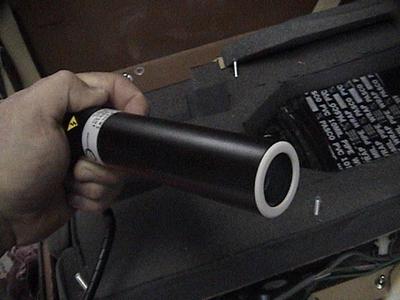
Here's a closeup of the new PMTs. They're very nice, well calibrated, lightweight, and groovy. Thanks, ElectronTubes, Inc., which supplied them at a very reasonable rate (these are very pricey items).
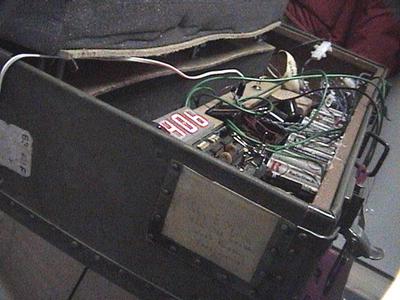
I included this picture for my brother. I mounted the detector inside one of my father's old suitcases from World War II. The address label, though it's hard to read in this picture, still gives his address from 1945 : Oak Terrace, West Reading, Pennsylvania.
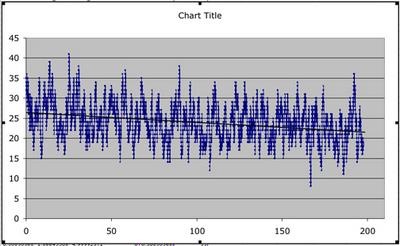
This is a graph of an experiment using the two detectors in coincidence, meaning the counter only registers a "hit" if both detectors hit nearly simultaneously, within about 20 nanoseconds. Coincidence technique lowers noise, because PMTs fire randomly from time to time, but are more unlikely to fire randomly at the same time. It also creates a "telescope", where parcticles from perpendicular to the scintillator paddles are more likely to hit than parcticles from other directions. The detectors were placed in coincidence at approximately 25 degrees from horizontal. They were pointed ahead of the sun. The question was, "Do the detectors see the sun ?" Or, more precisely,"Is it possible to measure parcticles directly from the sun ?" X axis is time in minutes, Y axis is counts per minute. The sun was directly perpendicular to the detectors at about 100 minutes. Any relationship between sun position and counts ? I don't think so. Why is the trend down ? I have some ideas. Check back tomorrow....

Moving snow away from the station is very big business here. The work goes on around the clock.
Contact the TEA in the field at
.
If you cannot connect through your browser, copy the
TEA's e-mail address in the "To:" line of
your favorite e-mail package.
|
